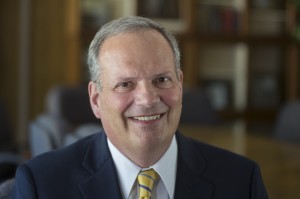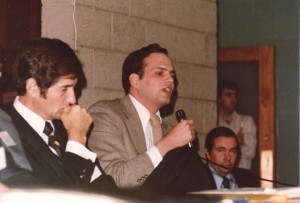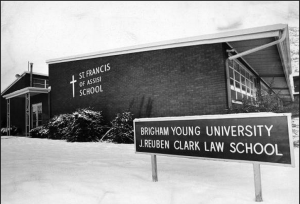Forty years have passed since the J. Reuben Clark Law School was founded in 1973, and few people can say they’ve been along for the whole ride. But Scott Cameron, associate dean of external relations, can.
Cameron, a member of the BYU Law School’s first class in 1976, will retire next month to serve a mission as the director of the Mesa Arizona Temple Visitors’ Center. Cameron has held various positions within the law school, including director of admissions, executive director of the Law Society and executive editor of the alumni magazine “Clark Memorandum.”

Cameron’s time spent at the law school has influenced hundreds of students and faculty, said Jane Wise, teacher of legal writing at the law school.
“As a dean of admissions, he shaped the experience of each student, each class and all of the alumni of the law school,” Wise said. “Nobody has had the kind of mark on this institution as Scott Cameron.”
Cameron’s wife, Christine, said whenever they attend law school events, she always has numerous past students and alumni express to her the difference her husband has made in their lives.
“They always say that he was influential in their decision to attend BYU,” Christine Cameron said. “He would ask them if they had prayed about it and if it would be the right decision for their futures. I can’t tell you how many people have said this to me.”
Cameron’s dedication to working hard and overcoming hard things can be seen in all areas of his life — from earning his bachelor’s and master’s degrees from Stanford University to overcoming colon cancer in 2003. His involvement in BYU law started in 1973 when he joined the first class.
“When it first opened, we met at the Saint Francis of Assisi Catholic school on Ninth East,” Cameron said. “Everything was very close, so there was a special relationship between the faculty, administration and students.”

At the time, there were only six faculty members, but class size was the same as it is today — 150 students. Cameron graduated from the law school in 1976. He then worked as a lawyer in Salt Lake City. Eleven years later, he served as the assistant superintendent of public instruction for the State of Utah before coming back to BYU’s law school in 1989. Shortly after his arrival at the law school, he became the executive director of the Law Society, an organization that allows alumni to mentor, network and help students find jobs.
“I’ve seen the Law Society grow from about 500 members to over 5,000,” Cameron said. “Now there are 105 chapters of the law society in the U.S. and Canada, Australia, New Zealand, Mexico, South America, Europe and even Africa.”
Cameron said the law school has grown rapidly since he was a student.
“The year I graduated, there were only six employers who interviewed students,” he said. “Now there are many more people who come here seeking BYU students. We’ve now had 37 graduating classes, so as they go out and do well in their communities, people say, ‘Oh, we feel good about hiring a BYU student since we’ve seen what great things this person has done.’ So, we’ve been able to establish a strong reputation for BYU law.”
Because of this good reputation, Cameron continues to have faith in BYU Law, despite recent national trends regarding a decline in law school applicants.
Cameron said he sees BYU law school’s influence all over the world. Visitors from other countries frequently visit the International Center for Law and Religious Studies, where they have positive associations with the law school and come to understand the value of religious freedom.

“As they see this, they are more likely to open up their countries so that more missionaries can come in,” Cameron said. “I see this as a significant benefit that the law school has to the greater Church.”
Cameron has served in at least five bishoprics, as a mission president of the Pennsylvania Pittsburgh mission and as a member of the General Young Men’s Board for The Church of Jesus Christ of Latter-day Saints.
“He has always been a man that inspires others to be greater men and women of faith within the law school community,” Wise said. “He’s done that within the law school, and I believe he will continue to do so after his retirement here and in the community.”




